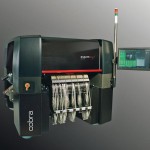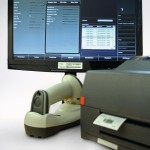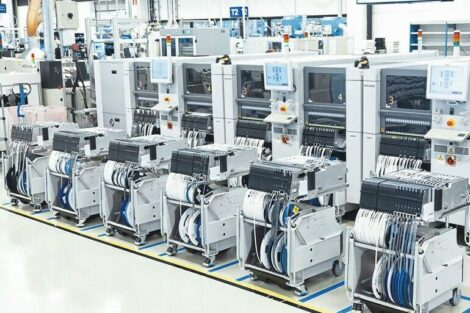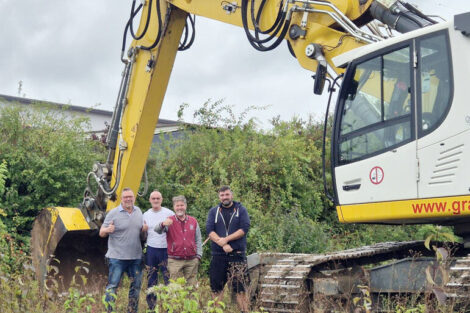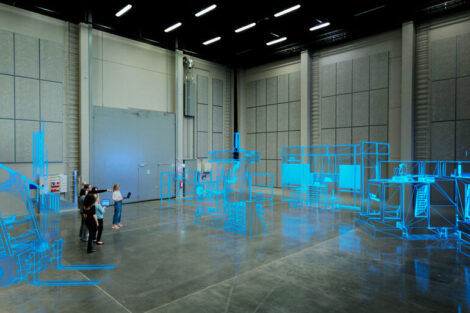Until recently, automation and flexibility have been seen as two incompatible goals in electronics manufacturing. But today, due to intelligent production concepts, even highly automated production lines can react flexibly to customer requirements and can produce small series for acceptable costs.
Adrian Schärli for Essemtec, Aesch (Switzerland)
Aristotle said that the whole is greater than the sum of its parts. In electronics manufacturing, this means that an integrated production can produce more than the simple collection of individual machines. Intelligent automated assembly systems are not only fast and accurate, but also highly flexible.
Small- and medium-size enterprises (SME) typically have highly versatile electronics production with many changeovers. Setup costs, production errors, stock movements and waiting times are main cost drivers. But in recent times, cost and time pressure have become stronger, even for niche products. Therefore, small producers also must integrate, register quality data and control, and reduce manufacturing costs.
Precise quantities with intelligent feeder system
Old production machines and time-consuming feeder setup may be reasons for producing more than is actually ordered, so that setup-costs can be divided by more PCBs. If the manufacturer is lucky, the overproduction can be sold with a later order.
However, overproduction can jeopardize a company and must be avoided. Even frame contracts are not real insurance. Automotive suppliers had to experience this painfully a few years ago when the required quantities suddenly shrank. Material and time had been wasted on products that were no longer needed.
It is better to produce only the quantity that is ordered and that will be paid for by the customer. Such a just-in-time production is only feasible with modern production systems that feature a high feeder capacity and intelligent feeder setup plans. This type of plan must consider which components are installed on the machines in sufficient quantity so that they do not have to be reinstalled.
SMD pick-and-place machines such as Essemtec’s Cobra, Paraquda or FLX in combination with eMIS software enable the organization of lean production. Production planning with eMIS can be simulated according to different parameters. For example, the production manager can decide on-screen if it would be better for the planned job to have an optimized, complete new feeder setup or to simply add the missing components to the machine.
Integrated planning reduces material stock
Flexible production often suffers from high material stock. The erratic demand and the risk of planning, purchasing and production errors lead to the purchase of more material rather than too little. However, the inventory is binded capital, it increases costs such as current assets, capital interests, management cost and the price of warehouse space. If the material has not been used before its expiration date, depreciation and disposal costs also must be factored in.
Therefore, minimizing inventory brings two advantages: reduced cost and logistical problems become visible and then can be solved. However, inventory reduction must be done in a controlled environment. It requires intelligent planning systems that know the current material consumption as well as future needs as accurately as possible. ERP systems have such functionalities; however, few can model the complexity of highly flexible electronics production.
The eMIS software is designed for such requirements because the software has been developed based on practical experience. The software directly communicates with pick-and-place machines and knows the current component consumption in real-time. Additionally, it tracks expiration dates and calculates remaining floor lifetime of components with moisture sensitivity level (MSL) classification
Quality from the beginning
It is always better to produce quality from the beginning instead of controlling it later. Rework and repair is both expensive and time consuming. Quality assurance measures in electronics production include high levels of experience and motivation from all employees, continuous service on production machines, and setup checks before the start of production. An important principle to follow is “the easier the machine operation, the fewer the errors that will occur.”
The eeZ software technology has been developed to increase production quality and flexibility. It is the base of the ePlace machine operation software and eMIS production management software suite. eeZ technology supports touch screens and simplifies the operation of complex systems. It supports operators with a multilingual help system, automatic command completion, input validation and other features that are standard on modern software.
Intelligent feeders and barcode-based setup verification are the base for strict quality assurance. Furthermore, the pick-and-place machines of the company feature virtual view, a combination of a live PCB view with virtual components. This allows positioning and alignment to be verified before production start, similar to the combination of satellite images with virtual streets on Web-based map systems.
Simulate line-balancing
Even if a machine does not produce, it still creates costs in the form of capital interest, service and space. Inline automated production lines with multiple pick-and-place machines often have standstill times. The reason is bad balancing of the placement work to the individual modules. Such complex plans are not feasible without integrated computer assistance. The simulation tool must have all data of the current situation as well as all production details of each individual component. With eMIS, for example, it is possible to simulate, optimize and test production in advance. The software even allows virtual assembly lines to be set up for more complex what-if analyses.
Store components within production
In the past, components were prepared for specific jobs, transported to production and back to storage after job completion. This was reliable; however, it involved high material inventory as well as increased logistics and stock movement efforts. Today, very compact automatic component storage systems such as the Tower from the company offer new possibilities. A Tower can bring the required component reel directly to the pick-and-place system. After production, the machine operator can replace the reel in the stock. This simple system avoids feeder setup errors. The stock motion is registered, the inventory is automatically corrected and transport routes are eliminated. A tower can even store MSL-classified components safely without any additional packing. Due to a temperature- and humidity-controlled environment, floor live time is kept constant after a reel has been stored inside the Tower. As such, the automatic storage system can save a great amount of expensive MSL packaging material.
Conclusion
Requirements for precision, quality assurance and traceability of electronics production have risen in recent years. What used to be required only in aerospace and medical industries has become standard in “normal” production as well. Cost and time pressure have increased even for SME manufacturers. Product lifecycles are becoming shorter and quality demands are raising. In order to withstand this pressure, electronics manufacturers must combine automation and flexibility. This is possible with integrated, intelligent and holistic automation concepts, such as those from the Swiss manufacturer.
SMT Hybrid Packaging
Booth 7-203
ZUSAmmenfassung
Der Artikel veranschaulicht, wie heute in der Elektronikfertigung dank intelligenter Konzepte auch automatische Produktionen flexibel auf Kundenwünsche reagieren, und Kleinserien kostengünstig produzieren werden können.
L’article illustre comment de nos jours, dans la fabrication électronique, et grâce à des concepts intelligents, il est possible de réagir de manière flexible aux souhaits des clients, également pour les productions automatiques, et de produire des petites séries à des prix intéressants.
Share:




